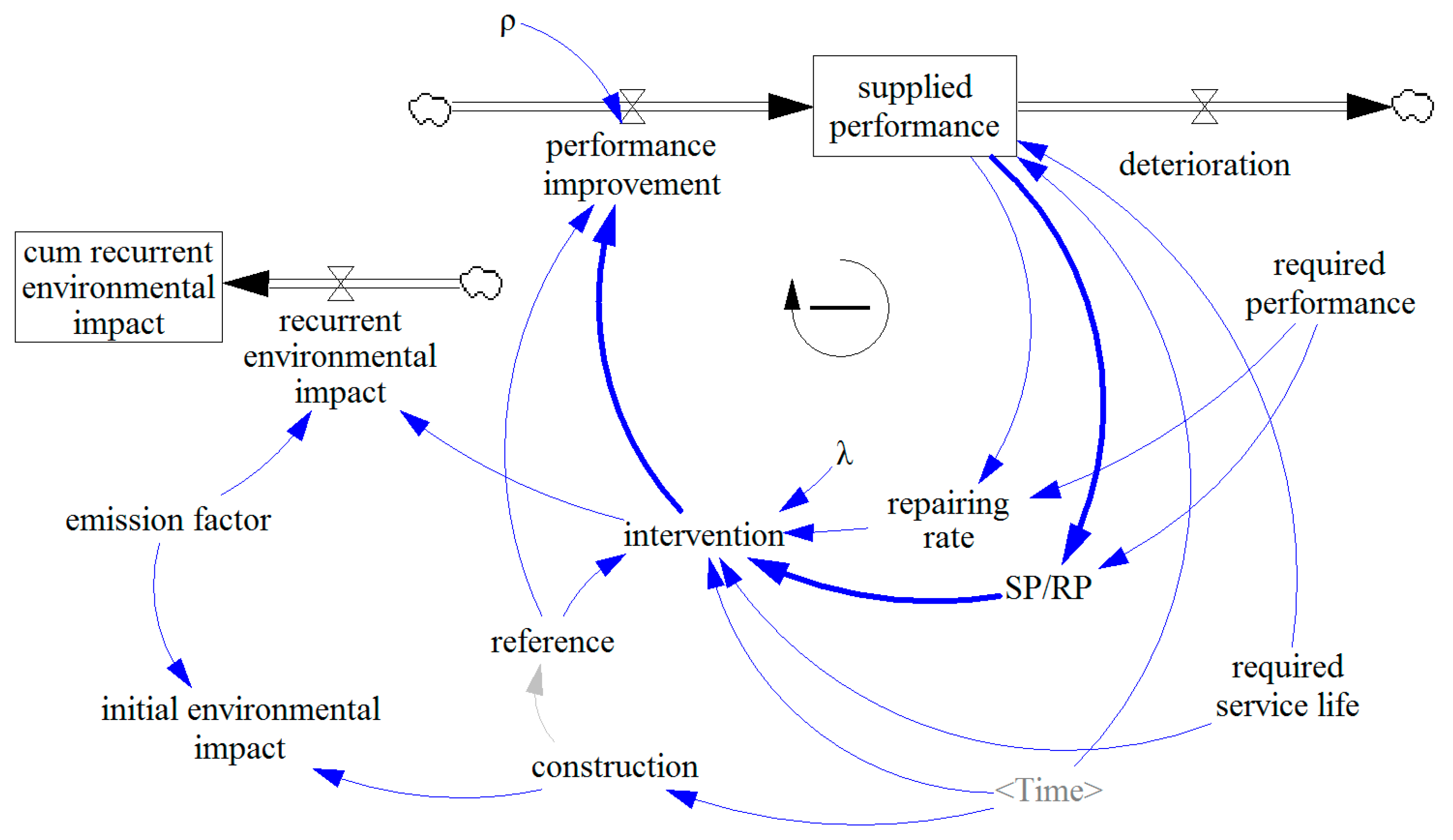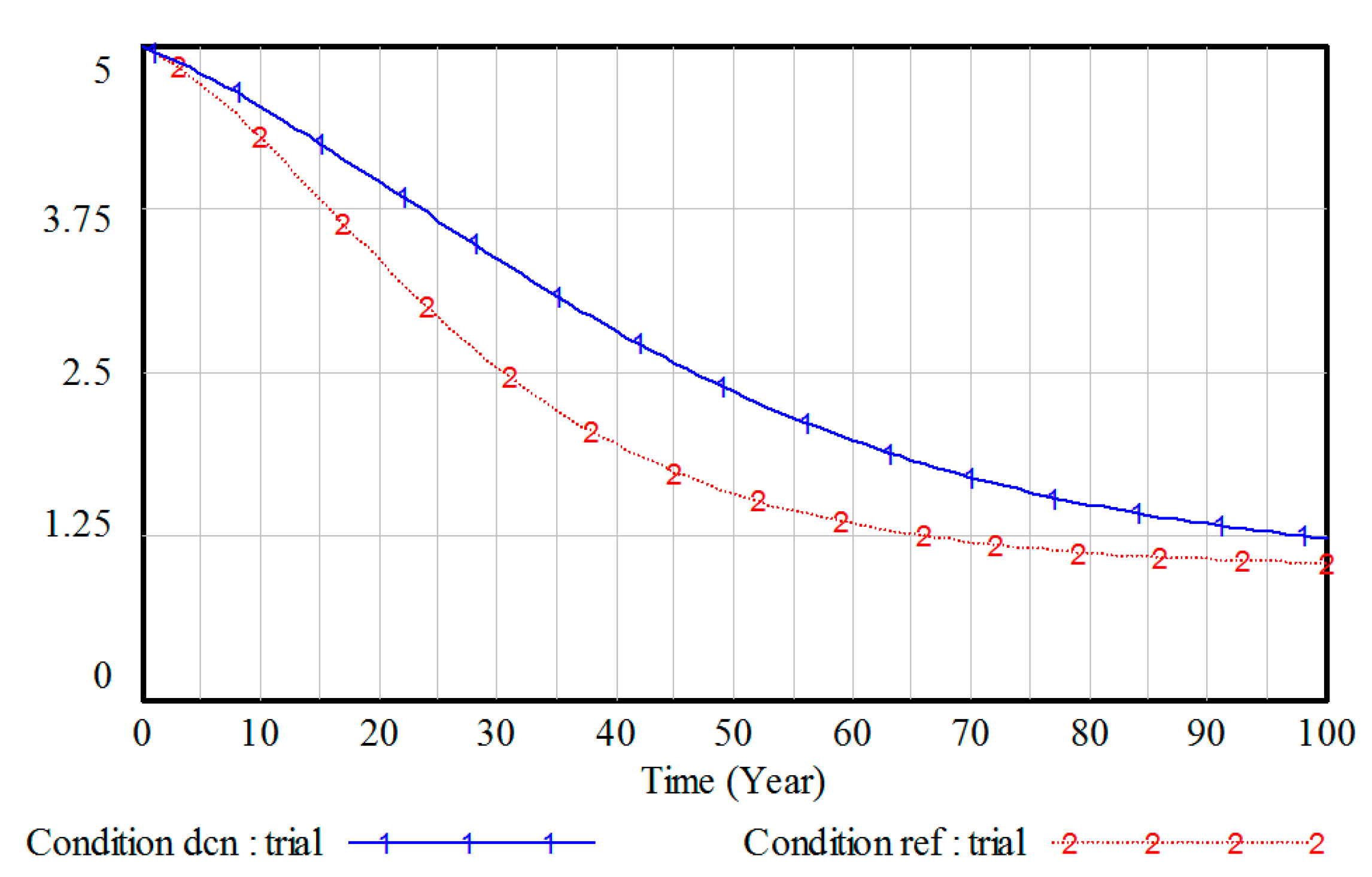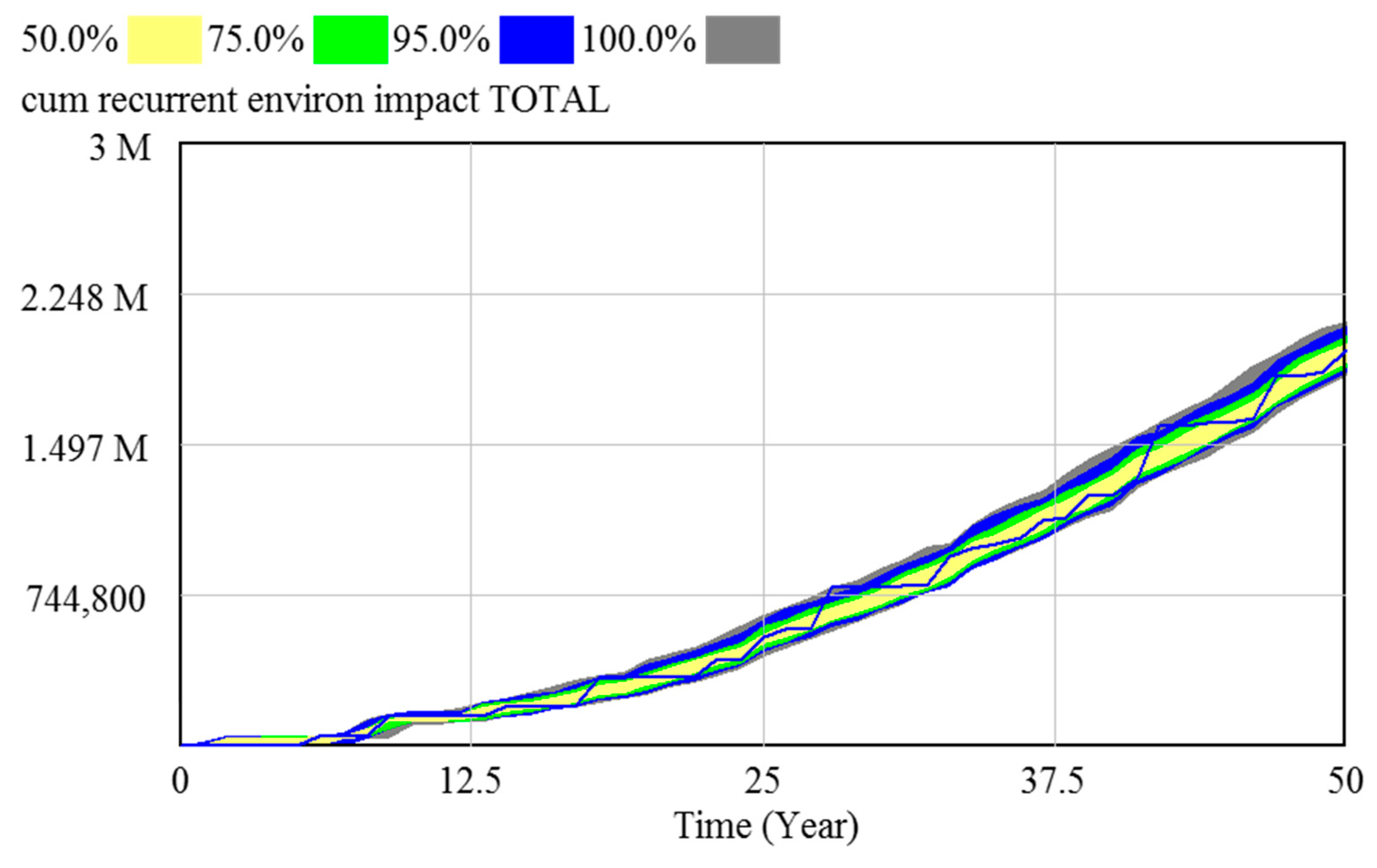Dynamic Lifecycle Assessment in Building Construction Projects: Focusing on Embodied Emissions
Abstract
:1. Introduction
2. Literature Review
3. Dynamic Factors in Recurrent EC
4. System Dynamics Model for DLCA
4.1. Causal Map and Feedback Loop
4.2. Stock and Flow Diagram (SFD)
IF THEN ELSE (“SP/RP” < λ, initial construction × repairing rate, 0))
5. Case Study
5.1. Data Information
5.2. Assumptions in the Case Study
5.3. Simulation
5.4. Sensitivity Analysis
6. Conclusions
Author Contributions
Funding
Conflicts of Interest
References
- Ji, C.; Hong, T.; Jeong, J.; Kim, J.; Lee, M.; Jeong, K. Establishing environmental benchmarks to determine the environmental performance of elementary school buildings using LCA. Energy Build. 2016, 127, 818–829. [Google Scholar] [CrossRef]
- Zuo, J.; Pullen, S.; Rameezdeen, R.; Bennetts, H.; Wang, Y.; Mao, G.; Zhou, Z.; Du, H.; Duan, H. Green building evaluation from a life-cycle perspective in Australia: A critical review. Renew. Sustain. Energy Rev. 2017, 70, 358–368. [Google Scholar] [CrossRef]
- Atmaca, A. Life cycle assessment and cost analysis of residential buildings in south east of Turkey: Part 1—Review and methodology. Int. J. Life Cycle Assess. 2016, 21, 831–846. [Google Scholar] [CrossRef]
- Geng, S.; Wang, Y.; Zuo, J.; Zhou, Z.; Du, H.; Mao, G. Building life cycle assessment research: A review by bibliometric analysis. Renew. Sustain. Energy Rev. 2017, 76, 176–184. [Google Scholar] [CrossRef]
- Anand, C.K.; Amor, B. Recent developments, future challenges and new research directions in LCA of buildings: A critical review. Renew. Sustain. Energy Rev. 2017, 67, 408–416. [Google Scholar] [CrossRef]
- Pomponi, F.; Moncaster, A. Embodied carbon mitigation and reduction in the built environment—What does the evidence say? J. Environ. Manag. 2016, 181, 687–700. [Google Scholar] [CrossRef] [PubMed]
- Su, S.; Li, X.; Zhu, Y.; Lin, B. Dynamic LCA framework for environmental impact assessment of buildings. Energy Build. 2017, 149, 310–320. [Google Scholar] [CrossRef]
- Collinge, W.O.; Liao, L.; Xu, H. Enabling dynamic life cycle assessment of buildings with wireless sensor networks. In Proceedings of the 2011 IEEE International Symposium on Sustainable Systems and Technology, Chicago, IL, USA, 16–18 May 2011; pp. 1–6. [Google Scholar]
- Collinge, W.; Landis, A.E.; Jones, A.K.; Schaefer, L.A.; Bilec, M.M. Indoor environmental quality in a dynamic life cycle assessment framework for whole buildings: Focus on human health chemical impacts. Build. Environ. 2013, 62, 182–190. [Google Scholar] [CrossRef]
- Collinge, W.O.; Landis, A.E.; Jones, A.K.; Schaefer, L.A.; Bilec, M.M. Dynamic life cycle assessment: Framework and application to an institutional building. Int. J. Life Cycle Assess. 2013, 18, 538–552. [Google Scholar] [CrossRef]
- Collinge, W.O.; Landis, A.E.; Jones, A.K.; Schaefer, L.A.; Bilec, M.M. Productivity metrics in dynamic LCA for whole buildings: Using a post-occupancy evaluation of energy and indoor environmental quality tradeoffs. Build. Environ. 2014, 83, 339–348. [Google Scholar] [CrossRef]
- Fouquet, M.; Levasseur, A.; Margni, M. Methodological challenges and developments in LCA of low energy buildings: Application to biogenic carbon and global warming assessment. Build. Environ. 2015, 90, 51–59. [Google Scholar] [CrossRef]
- Rahim, F.H.A.; Hawari, N.N.; Abidin, N.Z. Supply and demand of rice in Malaysia: A system dynamics approach. Int. J Sup. Chain. Mgt. 2017, 6, 1–7. [Google Scholar]
- ISO 14040:2006 Environmental Management-Life Cycle Assessment-Principles and Framework. Available online: https://www.iso.org/standard/37456.html (accessed on 8 July 2019).
- Gavotsis, E.; Moncaster, A. Improved embodied energy and carbon accounting: recommendations for industry and policy. Athens J. Tech. Eng. 2015, 2, 9–23. [Google Scholar] [CrossRef]
- Kang, G.; Kim, T.; Kim, Y.W.; Cho, H.; Kang, K.I. Statistical analysis of embodied carbon emission for building construction. Energy Build. 2015, 105, 326–333. [Google Scholar] [CrossRef]
- Brown, N.W.O.; Olsson, S.; Malmqvist, T. Embodied greenhouse gas emissions from refurbishment of residential building stock to achieve a 50% operational energy reduction. Build. Environ. 2014, 79, 46–56. [Google Scholar] [CrossRef]
- Dixit, M.K. Life cycle recurrent embodied energy calculation of buildings: A. review. J. Clean. Prod. 2019, 209, 731–754. [Google Scholar] [CrossRef]
- Negishi, K.; Tiruta-Barna, L.; Schiopu, N.; Lebert, A.; Chevalier, J. An operational methodology for applying dynamic Life Cycle Assessment to buildings. Build. Environ. 2018, 144, 611–621. [Google Scholar] [CrossRef]
- Su, S.; Li, X.; Zhu, Y. Dynamic assessment elements and their prospective solutions in dynamic life cycle assessment of buildings. Build. Environ. 2019, 158, 248–259. [Google Scholar] [CrossRef]
- Tarefder, R.A.; Rahman, M.M. Development of system dynamic approaches to airport pavements maintenance. J. Transp. Eng. 2016, 142, 04016027. [Google Scholar] [CrossRef]
- Davis, J.S.; Cable, J.H. Key Performance Indicators for Federal Facilities Portfolios, Federal Facilities Council Technical Report Number 147; The National Academies Press: Washington, DC, USA, 2005. [Google Scholar]
- Leather, P.; Littlewood, M.; Munro, M. Home-Owners and Housing Repair: Behavior and Attitudes; Joseph Rowntree Foundation (JRF): York, UK, 1998. [Google Scholar]
- Bitan, Y.; Meyer, J. Self-initiated and respondent actions in a simulated control task. Ergonomics 2007, 50, 763–788. [Google Scholar] [CrossRef]
- Shavartzon, A.; Azaria, A.; Kraus, S.; Goldman, C.V.; Meyer, J.; Tsimhoni, O. Personalized alert agent for optimal user performance. In Proceedings of the Thirtieth AAAI Conference on Artificial Intelligence, Phoenix, AZ, USA, 12–17 February 2016. [Google Scholar]
- Sterman, J.D. Business Dynamics: Systems Thinking and Modeling for a Complex World; McGraw: New York, NY, USA, 2000. [Google Scholar]
- Meadows, D. Thinking in Systems: A Primer; Earthscan: London, UK, 2008. [Google Scholar]
- International Association of Certified Home Inspectors (InterNACHI). InterNACHI’s Standard Estimated Life Expectancy Chart for Home. Available online: https://www.nachi.org/life-expectancy.htm (accessed on 15 May 2019).
- Seiders, D.; Ahluwalia, G.; Melman, S.; Quint, R.; Chaluvadi, A.; Liang, M.; Silverberg, A.; Bechler, C.; Jackson, J. Study of Life Expectancy of Home Components; National Association of Home Builders (NAHB), Bank of America (BoA) Home Equity: Washington, DC, USA, 2007. [Google Scholar]
- Seiders, K.; Voss, G.B.; Godfrey, A.L.; Grewal, D. SERVCON: Development and validation of a multi-dimensional service convenience scale. J. Acad. Mark. Sci. 2007, 35, 144–156. [Google Scholar] [CrossRef]
- Shin, S.; Tae, S.; Woo, J.; Roh, S. The development of environmental load evaluation system of a standard Korean apartment house. Renew. Sustain. Energy Rev. 2011, 15, 1239–1249. [Google Scholar] [CrossRef]
- Choi, D.S.; Chun, H.C.; Ahn, J.Y. Prediction of Environmental Load Emissions from an Apartment House of Construction Phase through the Selection of Major Materials. J. Archit. Inst. Korea Plan. Des. 2012, 28, 237–246. [Google Scholar]
- Korea Environmental Industry & Technology Institute (KEITI). Korea Life Cycle Inventory Database. 2004. Available online: http://www.epd.or.kr/lci/lciDb.do (accessed on 15 May 2019).
- Korea Institute of Civil Engineering and Building Technology. The Final Report of National DB on Environmental Information of Building Materials; KICT: Goyang, Korea, 2008. [Google Scholar]
- EN 15978:2011 Sustainability of construction works-Assessment of the environmental performance of buildings-Calculation methods. Available online: https://shop.bsigroup.com/ProductDetail?pid=000000000030256638 (accessed on 8th July 2019).
- IPWEA. International Infrastructure Management Manual. Available online: https://www.ipwea.org/publications/ipweabookshop/iimm (accessed on 8th July 2019).
- Keshavarzrad, P.; Setunge, S.; Zhang, G. Deterioration prediction of building components. In Proceedings of the 2014 Sustainability in Public Works Conference, Tweed Heads, Australia, 27–29 July 2014; pp. 1–9. [Google Scholar]
- Madanat, S.; Mishanlani, R.; Ibrahim, W.H.W. Estimation of infrastructure transition probabilities from condition rating data. J. Infrastruct. Syst. 1995, 19, 120–125. [Google Scholar] [CrossRef]
- Baik, H.S.; Jeong, H.S.; Abraham, D.M. Estimating Transition Probabilities in Markov Chain-Based Deterioration Models for Management of Wastewater Systems. J. Water Resour. Plan. Manag. 2006, 132, 15–24. [Google Scholar] [CrossRef]
- Sharabah, A.; Setunge, S.; Zeephongsekul, P. A Reliability Based Approach for Service Life Modeling of Council Owned Infrastructure Assets. In Proceedings of the ICOMS Asset Management Conference, Melbourne, Australia, 22–25 May 2007. [Google Scholar]
- Edirisinghe, R.; Setunge, S.; Zhang, G. Markov Model-Based Building Deterioration Prediction and ISO Factor Analysis for Building Management. J. Manag. Eng. 2015, 31, 04015009. [Google Scholar] [CrossRef]








| Item | Unit | Emission Factors (kgCO2eq/Unit) | Reference |
|---|---|---|---|
| High tensile rebar | kg | 3.962 × 10−1 | KICT |
| Ready-mixed concrete, 25-210-12 | m3 | 4.001 × 102 | KEITI |
| Ready-mixed concrete, 25-240-15 | m3 | 4.196 × 102 | KEITI |
| Concrete brick | kg | 1.222 × 10−4 | KICT |
| Cement | ton | 1.049 × 103 | KEITI |
| EPS foam | kg | 2.024 | KICT |
| Tile | kg | 3.454 × 10−1 | KICT |
| Granite | kg | 4.421 | KEITI |
| Gypsum board | kg | 1.383 × 10−1 | KEITI |
| Mineral wool board | kg | 1.482 | KEITI |
| Paint, Water-soluble emulsion type | ton | 3.089 × 102 | KEITI |
| Paint, Amino-alkyd type | ton | 7.833 × 102 | KEITI |
| Paint, Epoxy type | ton | 3.158 × 103 | KEITI |
| MDF flooring | EA | 1.844 | KICT |
| PVC wallpaper | m2 | 1.953 | KICT |
| Case Study | Variables | Assumption |
|---|---|---|
| LCA | Transportation | Delivery distance is assumed to be 20 km for every material. |
| Lifting | Allocation rules with lifting weight are applied to common equipment (tower crane, construction lift). | |
| Carriage-on-site | While they are emission sources, they are not accounted for. | |
| M&R activities | While they are emission sources, they are not accounted for. | |
| Simulation | Performance | Performance is quantified in a five-point scale. |
| Deterioration | Deterioration curve refer to the existing literature [37]. | |
| M&R history | M&R history data are assumed from the guidelines of the Enforcement Decree of the Multi-Family Housing Management Act. |
| Elements | λ | ρ | Required Performance | Simulations (Times) | Payoff |
|---|---|---|---|---|---|
| M-RO | 0.90 | 14.40 | 4.01 | 490 | −1.70 × 108 |
| M-IF | 0.90 | 14.85 | 4.00 | 661 | −2.67 × 109 |
| T-RO | 0.90 | 35.12 | 4.06 | 652 | −2.52 × 104 |
| T-IW | 1.20 | 35.41 | 4.01 | 833 | −6.80 × 1010 |
| T-IF | 0.90 | 148.87 | 4.16 | 734 | −1.19 × 107 |
| S-EW | 0.93 | 50.00 | 4.05 | 632 | −1.20 × 109 |
| I-IC | 0.93 | 10.00 | 4.00 | 444 | −3.30 × 108 |
| I-IW | 0.91 | 1.00 | 4.30 | 469 | −2.95 × 109 |
| P-EW | 1.17 | 8.45 | 4.00 | 562 | −4.80 × 108 |
| P-IC | 1.20 | 8.44 | 4.39 | 660 | −1.14 × 107 |
| P-IW | 1.17 | 8.45 | 4.00 | 562 | −8.97 × 107 |
| P-ST | 1.17 | 8.48 | 4.00 | 456 | −1.25 × 104 |
| D-IF | 0.90 | 21.01 | 3.99 | 732 | −1.40 × 1012 |
| D-IW | 0.90 | 19.18 | 4.00 | 438 | −3.38 × 1010 |
| λ | GHGs Emission (kgCO2eq) | |||||
|---|---|---|---|---|---|---|
| Component | Min | Max | Min | Max | Stdev | (Max-Min)/Avg |
| M-RO | 0.81 | 0.99 | 14,188 | 15,085 | 320 | 6.1% |
| M-IF | 0.81 | 0.99 | 55,720 | 60,821 | 1417 | 8.8% |
| T-RO | 0.81 | 0.99 | 168 | 201 | 11 | 17.6% |
| T-IW | 1.08 | 1.32 | 94,314 | 94,314 | 0 | 0.0% |
| T-IF | 0.81 | 0.99 | 4453 | 6881 | 991 | 44.4% |
| S-EW | 0.84 | 1.03 | 16,762 | 43,086 | 7296 | 101.8% |
| I-IC | 0.84 | 1.03 | 18,331 | 18,331 | 0 | 0.0% |
| I-IW | 0.82 | 1.00 | 44,641 | 44,641 | 0 | 0.0% |
| P-EW | 1.05 | 1.28 | 26,235 | 26,235 | 0 | 0.0% |
| P-IC | 1.08 | 1.32 | 4039 | 4039 | 0 | 0.0% |
| P-IW | 1.05 | 1.28 | 35,845 | 35,845 | 0 | 0.0% |
| P-ST | 1.05 | 1.29 | 134 | 134 | 0 | 0.0% |
| D-IF | 0.81 | 0.99 | 1,417,770 | 1,600,330 | 52,475 | 12.5% |
| D-IW | 0.81 | 0.99 | 195720 | 195,720 | 0 | 0.0% |
| Total | - | - | 1,930,130 | 2,140,150 | 53,182 | 10.6% |
| Required Performance | GHGs Emission (kgCO2eq) | |||||
|---|---|---|---|---|---|---|
| Component | Min | Max | Min | Max | Stdev | (Max-Min)/Avg |
| M-RO | 3.61 | 4.42 | 13,733 | 15,344 | 425 | 11.2% |
| M-IF | 3.60 | 4.40 | 54,868 | 61,930 | 1644 | 12.3% |
| T-RO | 3.66 | 4.47 | 169 | 227 | 14 | 31.1% |
| T-IW | 3.61 | 4.41 | 75,569 | 139,221 | 14,571 | 64.7% |
| T-IF | 3.75 | 4.58 | 2929 | 7154 | 1074 | 97.6% |
| S-EW | 3.65 | 4.46 | 20,787 | 20,787 | 0 | 0.0% |
| I-IC | 3.60 | 4.40 | 18,331 | 18,331 | 0 | 0.0% |
| I-IW | 3.87 | 4.73 | 44,641 | 44,641 | 0 | 0.0% |
| P-EW | 3.60 | 4.40 | 26,235 | 26,235 | 0 | 0.0% |
| P-IC | 3.95 | 4.83 | 4039 | 4039 | 0 | 0.0% |
| P-IW | 3.60 | 4.40 | 35,845 | 35,845 | 0 | 0.0% |
| P-ST | 3.60 | 4.40 | 134 | 134 | 0 | 0.0% |
| D-IF | 3.59 | 4.39 | 1,357,820 | 1,622,000 | 62,445 | 18.1% |
| D-IW | 3.60 | 4.40 | 195,720 | 195,720 | 0 | 0.0% |
| Total | - | - | 1,848,360 | 2,111,350 | 61,997 | 13.4% |
© 2019 by the authors. Licensee MDPI, Basel, Switzerland. This article is an open access article distributed under the terms and conditions of the Creative Commons Attribution (CC BY) license (http://creativecommons.org/licenses/by/4.0/).
Share and Cite
Kang, G.; Cho, H.; Lee, D. Dynamic Lifecycle Assessment in Building Construction Projects: Focusing on Embodied Emissions. Sustainability 2019, 11, 3724. https://doi.org/10.3390/su11133724
Kang G, Cho H, Lee D. Dynamic Lifecycle Assessment in Building Construction Projects: Focusing on Embodied Emissions. Sustainability. 2019; 11(13):3724. https://doi.org/10.3390/su11133724
Chicago/Turabian StyleKang, Goune, Hunhee Cho, and Dongyoun Lee. 2019. "Dynamic Lifecycle Assessment in Building Construction Projects: Focusing on Embodied Emissions" Sustainability 11, no. 13: 3724. https://doi.org/10.3390/su11133724





